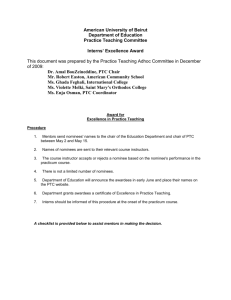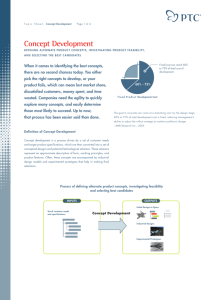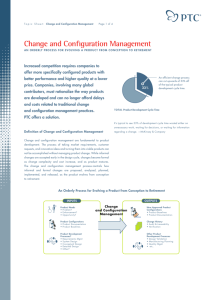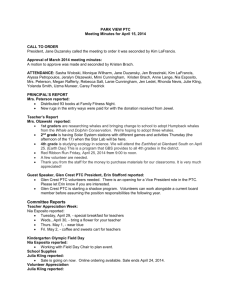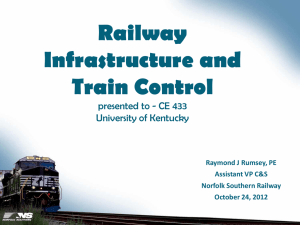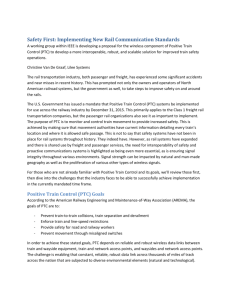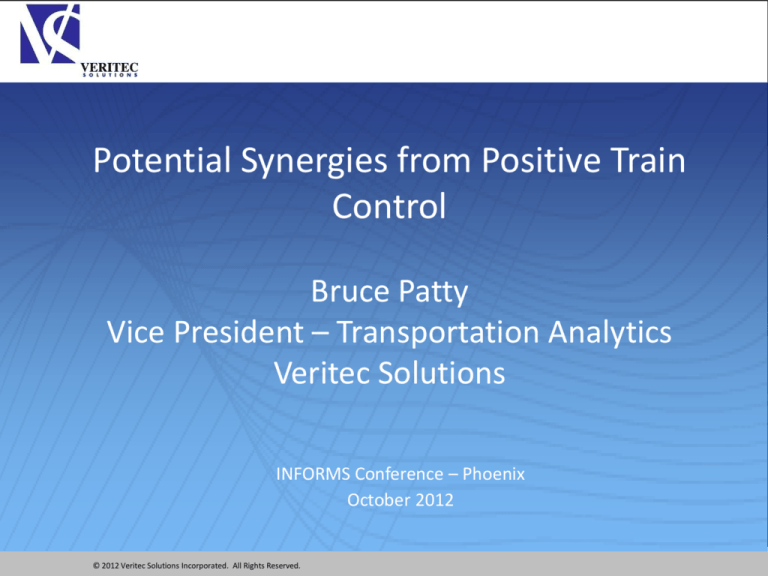
Potential Synergies from Positive Train
Control
Bruce Patty
Vice President – Transportation Analytics
Veritec Solutions
INFORMS Conference – Phoenix
October 2012
© 2012 Veritec Solutions Incorporated. All Rights Reserved.
© 2012 Veritec Solutions Incorporated. All Rights Reserved.
Outline
Opportunities to Leverage Information to
Generate Benefits
-
-
Assessment of Potential Benefits from PTC from 6 Areas
Assumptions and Caveats
Linkages or Synergies between PTC and other systems for
some areas
Integration
Needs
Conclusions
© 2012 Veritec Solutions Incorporated. All Rights Reserved.
© 2012 Veritec Solutions Inc. All Rights Reserved.
2
Thanks
My sincere appreciation to our Session
Chair, Carl Van Dyke, for providing me with
much of the background material used to
develop this presentation
© 2012 Veritec Solutions Incorporated. All Rights Reserved.
© 2012 Veritec Solutions Inc. All Rights Reserved.
3
Opportunities to Leverage Information
Line Capacity
-
Theory: PTC could increase capacity by allowing trains to operate on shorter headways
-
Assumes PTC would use moving blocks or dynamic headways
-
Current PTC implementation plans do not support this
-
Should see line capacity improvements on over-capacitated “dark territory”
-
Diversion of funds to PTC implementation could actually reduce amount of capital available
for capacity expansion
Service Reliability
-
Theory: PTC could improve reliability by reducing delays and increasing average train speeds
-
Improved service quality and reliability would allow shippers to reduce supply chain costs and
make rail service more attractive, especially for intermodal
-
However, independent implementations of Precision Dispatching do not rely on PTC to
achieve this goal
-
Potential benefits here are not nearly as large as they were before railroads became so much
more reliable
© 2012 Veritec Solutions Incorporated. All Rights Reserved.
© 2012 Veritec Solutions Inc. All Rights Reserved.
4
Opportunities to Leverage Information
Efficient use of cars and locomotives
-
Theory: Real time location information provided by PTC will enable railroad managers to
increase asset productivity through improved decisions
-
Dynamic car scheduling systems could use location information to re-trip cars as needed
based on updated arrival times into terminals
-
Locomotive scheduling systems could use location information to update locomotive
assignments based on real time information
-
However, GPS systems on locomotives can already provide this information without PTC,
assuming that consists are linked to locomotive information
Fuel savings
-
Theory: Real time information will allow dispatchers to “pace” trains between scheduled meet
points, permitting fuel savings
-
Trains would not always operate at top speeds in order to reduce delays
-
However, this can already be accomplished using Precision Dispatching approaches that are
not reliant upon PTC
© 2012 Veritec Solutions Incorporated. All Rights Reserved.
© 2012 Veritec Solutions Inc. All Rights Reserved.
5
Opportunities to Leverage Information
Reduction in locomotive failures
-
Theory: Digital communications provided via PTC can be used to report diagnostic data on
locomotives in real time
-
This would allow pre-planning of maintenance activities and warnings of impending problems
-
However, “health” monitoring systems have already been installed in many modern, digital
locomotives, so this is not PTC-dependent
Improved track maintenance windows
-
Theory: Real-time accurate information on train location should increase the productivity of
track crews
-
This is needed because increased traffic density has made scheduling of maintenance more
and more difficult
-
However, six of the seven Class I railroads have developed technology so that maintenance
crews have visibility to train location information through a web application
© 2012 Veritec Solutions Incorporated. All Rights Reserved.
© 2012 Veritec Solutions Inc. All Rights Reserved.
6
Integration of Approaches can Add More Value
Many of the benefits that were originally identified with PTC or other
communication-based train control system have been realized through
the deployment of other business systems
•
•
•
•
•
Cellular networks
GPS systems mounted on locomotives
Precision dispatching
AEI
Web-based communication systems for track crews
It would appear that these approaches have been implemented in a
“piecemeal” manner to address the needs of individual railroad
departments
• Technologies need to be unified at the enterprise network so that
more can be achieved for less
© 2012 Veritec Solutions Incorporated. All Rights Reserved.
© 2012 Veritec Solutions Inc. All Rights Reserved.
7
Integration of Approaches can Add More Value
What could the integration of all these approaches allow?
-
One example -- Unifying the movement planner, PTC communications system, PTC onboard
computer and display, and Train Energy Management System would allow for the
development of “dynamic trip plans”
•
For each train
•
For each car
•
For each terminal
•
For each customer
Think about what this would mean for the demand for real-time
OR tools and models to manage the railroad?
© 2012 Veritec Solutions Incorporated. All Rights Reserved.
© 2012 Veritec Solutions Inc. All Rights Reserved.
8
Conclusion
Initial assumptions about the benefits of PTC used theories that
did not take into account the proliferation of other technologies
These technologies, in general, however have not been wellintegrated into a unified structure
Linking these together provides an environment that is “target
rich” for opportunities for real-time OR tools and would take
advantage of the synergies between these various technologies
© 2012 Veritec Solutions Incorporated. All Rights Reserved.
© 2012 Veritec Solutions Inc. All Rights Reserved.
9

